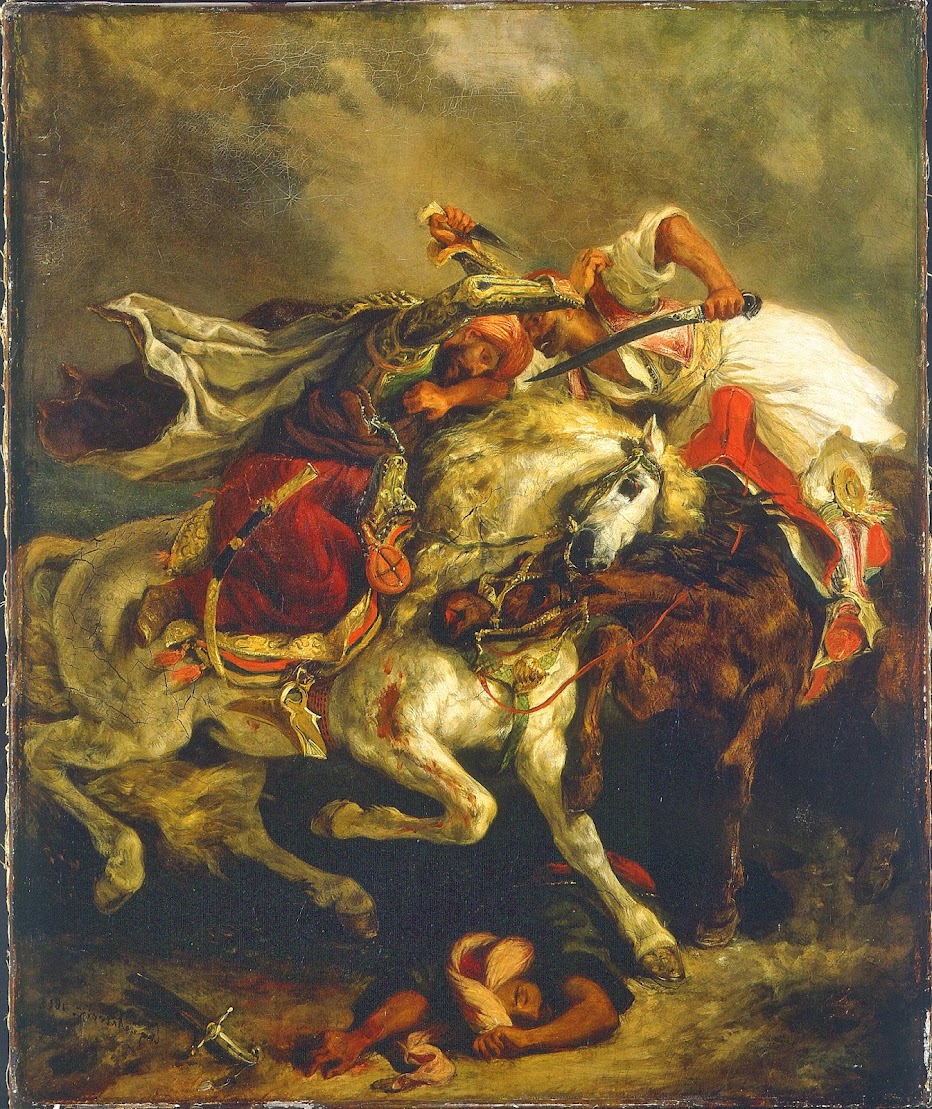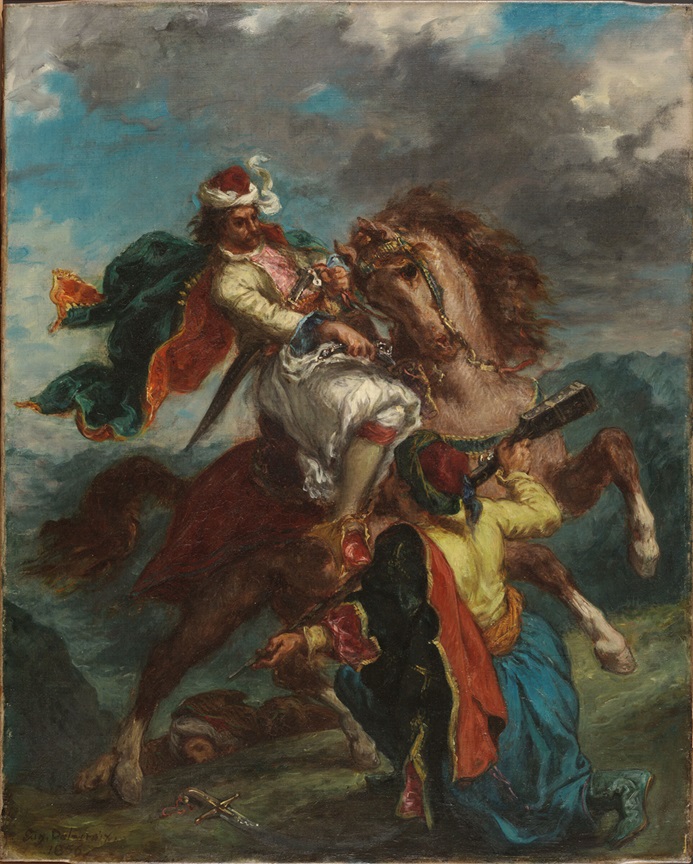Eugène Delacroix (1798–1863)
Combat du Giaour et Hassan/ The Combat of the Giaour and Hassan, c. 1826
Oil on canvas
height: 59.6 cm (23.4 in); width: 73.4 cm (28.8 in)
Art Institute of Chicago
Europeans’ interest in fantastical and often violent depictions of Middle Eastern, North African, and Asian cultures, which reinforced colonialist aims. Although Eugène Delacroix did not visit North Africa until 1832, he began painting Orientalist subjects early on in his career.
More on this painting
Eugène Delacroix (1798–1863)
Combat du Giaour et du Pacha/ Combat of the Giaour and the Pasha, c. 1835
Oil on canvas
height: 73 cm (28.7 in); width: 61 cm (24 in)
Petit Palais
The Giaour, erect above his saddle, tears with a wild smile the fabric covering the pasha's chest to reach the heart with the sharp blade of his sword. The pasha, in unstable balance on his horse, clutching his dagger in his right hand, tries to repel his assailant with the other hand. The ferocity of the fight is also expressed in the attitude of the horses, the black horse biting the white horse on the chest, already wounded in the thigh. The latter seems reluctant to step on the corpse of a Muslim lying on the ground. For Delacroix, the subject is above all a pretext to depict a close combat of great intensity. More on this painting
I only found two of the three mentioned painting!
Eugène Delacroix (French, 1798-1863)
A Turk Surrenders to a Greek Horseman, c. 1856
Oil on paper laid down on canvas
80 x 64.1 cm (31 1/2 x 25 1/4 in.)
Private collection
In the mid-1850s, Delacroix returned to themes he had treated thirty years earlier, though with an important difference. Rather than carefully distinguish literary from historical and topical subjects, he conflated them, as in this instance. Here, he draws on Byron’s description of the giaour (a Turkish slur for non-Muslims) overcoming the Turkish pasha in his poem “The Giaour, a Fragment of a Turkish Tale” (1813). To a contemporary audience, the composition could have appeared to be an episode from the Greek War of Independence (1821–32), a romantic cause célèbre that had inspired two of Delacroix’s large canvases of the 1820s. The result is a nostalgic invention that appealed to mid-century French orientalist fantasies. More on this painting
Ferdinand Victor Eugène Delacroix (26 April 1798 – 13 August 1863) was a French Romantic artist regarded from the outset of his career as the leader of the French Romantic school.
As a painter and muralist, Delacroix's use of expressive brushstrokes and his study of the optical effects of colour profoundly shaped the work of the Impressionists, while his passion for the exotic inspired the artists of the Symbolist movement. A fine lithographer, Delacroix illustrated various works of William Shakespeare, the Scottish author Walter Scott and the German author Johann Wolfgang von Goethe.
Delacroix took for his inspiration the art of Rubens and painters of the Venetian Renaissance, with an attendant emphasis on colour and movement rather than clarity of outline and carefully modelled form. Dramatic and romantic content characterized the central themes of his maturity, and led him not to the classical models of Greek and Roman art, but to travel in North Africa, in search of the exotic. Friend and spiritual heir to Théodore Géricault, Delacroix was also inspired by Lord Byron, with whom he shared a strong identification with the "forces of the sublime", of nature in often violent action.
However, Delacroix was given to neither sentimentality nor bombast, and his Romanticism was that of an individualist. In the words of Baudelaire, "Delacroix was passionately in love with passion, but coldly determined to express passion as clearly as possible."
More on Ferdinand Victor Eugène Delacroix
Please visit my other blogs: Art Collector, Mythology, Marine Art, Portrait of a Lady, The Orientalist, Art of the Nude and The Canals of Venice, Middle East Artists, 365 Saints, 365 Days, and Biblical Icons, also visit my Boards on Pinterest
Images are copyright of their respective owners, assignees or others.
Some Images may be subject to copyright
I don't own any of these images - credit is always given when due unless
it is unknown to me. if I post your images without your permission, please tell
me.
I do not sell art, art prints, framed posters or reproductions. Ads are
shown only to compensate the hosting expenses.
If you enjoyed this post, please share with friends and family.
Thank you for visiting my blog and also for liking its posts and pages.
Please note that the content of this post primarily consists of articles
available from Wikipedia or other free sources online.



No comments:
Post a Comment